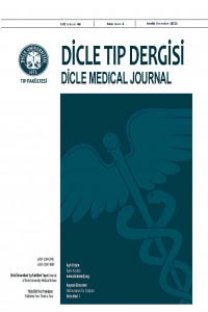Malformations of cortical development and epilepsy: Clinical, EEG and neuroimaging findings in children
Kortikal gelişim bozukluğu ve epilepsi: Çocuklarda klinik, EEG ve nörogörüntüleme bulguları
___
- 1. Tassi L, Colombo N, Garbelli R, et al. Focal cortical dysplasia: neuropathological subtypes, EEG, neuroimaging and surgical outcome. Brain 2002;125:1719-1732.
- 2. Leventer RJ, Jansen A, Pilz DT, et al. Clinical and imaging heterogeneity ofpolymicrogyria: a study of 328 patients. Brain 2010;133:1415-1427.
- 3. Krsek P, Maton B, Korman B, et al. Different features ofhistopathological subtypes of pediatric focal cortical dysplasla. Ann Neurol 2008;63:758-769.
- 4. Fauser S, Huppertz HJ, Bast T, et al. Clinical characteristics in focal cortical dysplasia: a retrospective evaluation in a series of 120 patients. Brain 2006;129:1907-1916.
- 5. Guerrini R, Holthausen H, Parmeggiani L, et al. Epilepsy and malformations of cerebral cortex. Epileptic syndromes in infancy, childhood and adolescence. London: John Libbey and Co Ltd.; 2002.p.457-479.
- 6. Sisodiya SM. Malformation of cortical development: burdens and insights from important causes of human epilepsy. Lancet Neurol 2004;3:29-38.
- 7. Mischel PS, Nguyen LP, Vinters HV. Cerebral cortical dysplasia associated with pediatric epilepsy. Review of neuropathologic features and proposal for a grading system. J Neuropathol Experimental Neurol 1995;54:137-153.
- 8. Brodtkorb E, Nilsen G, Smevik O, et al. Epilepsy and anomalies of neuronal migration: MRI and clinical aspects. Acta Neurol Scand 1992;86:24-32.
- 9. Li LM, Fish DR, Sisodiya SM, et al. High resolution magnetic resonance imaging in adults with partial or secondary generalized epilepsy attending a tertiary referral unit. J Neurol Neurosurg Psychiatry 1995;59:384-387.
- 10. Dobyns WB, Elias ER, Newlin MS, et al. Causal heterogeneity in isolated lissencephaly. Neurology 1992;42:1375- 1388.
- 11. Kurul S, Cakmakçi H, Dirik E. Agyria-pachygyria complex: MR findings and correlation with clinical features. Pediatr Neurol 2004;30:16-23.
- 12. Bittles AH. Consanguineous marriage and childhood health. Dev Med Child Neurol 2003;45:571-576.
- 13. Raymond AA, Fish DR, Sisodiya SM, et al. Abnormalities of gyration, heterotopias, tuberous sclerosis, focal cortical dysplasia, microdysgenesis, dysembryoplastic neuroepithelial tumor and dysgenesis of the archicortex in epilepsy: clinical, EEG and neuroimaging features in 100 adult patients. Brain 1995;118:620-660.
- 14. Montenegro MA, Cendes F, Lopes-Cendes I, et al. The clinical spectrum of malformations of cortical development. Arq Neuropsiquiatr 2007;65(2A):196-201.
- 15. Mathew T, Srikanth SG, Satishchandra P. Malformations of cortical development (MCDs) and epilepsy: experience from a tertiary care center in south India. Seizure 2010;19:147-152.
- 16. Leventer RJ, Phelan EM, Coleman LT, et al. Clinical and imaging features of cortical malformations in childhood. Neurology 1999 Sep 11;53:715-722.
- 17. Kovac S, Micallef C, Diehl B, et al. Mystery Case: Bilateral posterior periventricular heterotopias. Neurology 2013 Nov 26;81:e163-4
- 18. Guerrini R. Genetic malformations of the cerebral cortex and epilepsy. Epilepsia 2005;46 (Suppl):32-37.
- 19. Kuzniecky RI, Garcia J, Faught E. Cortical dysplasia in temporal lobe epilepsy: magnetic resonance imaging correlations. Ann Neurol 1991;29:293-298.
- 20. Güngör S, Yalnizoğlu D, Turanli G, et al. Malformations of cortical development: clinical spectrum in a series of 101 patients and review of the literature (Part II). Turk J Pediatr 2007;49:131-140.
- 21. Koehn MA, Duchowny M. Preoperative clinical evaluation and noninvasive electroencephalogram in cortical dysplasia. Neurosurg Clin N Am 2002;37:35-39.
- 22. Kuzniecky RI. Magnetic resonance imaging in developmental disorders of the cerebral cortex. Epilepsia 1994;35(suppl 6):S44 -S56.
- 23. Pascual Castroviejo I, Pascual Pascual SI, Via o J, et al. Malformations of cortical development and their clinical repercussions in a series of 144 cases. Rev Neurol 2003;37:327-344.
- ISSN: 1300-2945
- Yayın Aralığı: 4
- Başlangıç: 1963
- Yayıncı: Cahfer GÜLOĞLU
OĞUZ KARAHAN, Sinan DEMİRTAŞ, Umut Serhat SANRI, Fahri Hayri ATLI, Ahmet ÇALIŞKAN, Celal YAVUZ, Şinasi MANDUZ
Dyke-Davidoff-Masson sendromu iki olgu sunumu
Mehmet Deniz BULUT, İsmail GULSEN, Aydın BORA, ALPASLAN YAVUZ, CEMİL GÖYA, ABDUSSAMET BATUR
Böbrek taşı olgularında tam tüpsüz standart perkütan nefrolitotominin etkinlik ve güvenirliği
Cemil AYDIN, Ramazan TOPAKTAŞ, Selçuk ALTIN, Ali AKKOÇ, Zeynep Banu AYDIN, AYKUT AYKAÇ
Üst gastrointestinal sistem kanaması nedeniyle izlenen hastaların değerlendirilmesi
Hüseyin GÖLGELİ, Şamil ECİRLİ, Orkide KUTLU, HÜSNİYE BAŞER, Deniz KARASOY
AYTEKİN ÇIKMAN, Nadire Seval GÜNDEM, Barış GÜLHAN, Merve AYDIN, MEHMET PARLAK, Yasemin BAYRAM
The effects of insulin on the expression levels of ADAMTS6 & 19 in OUMS-27 cell
Veli UĞURCU, Sümeyya AKYOL, Aynur ALTUNTAŞ, Rıdvan FIRAT, S. Fatih KURŞUNLU, Özlem ÇAKMAK, Kadir DEMİRCAN
Raynaud fenomeni'ni taklit eden kompleks bölgesel ağrı sendromu tip 1
Pulmoner emboli için kazanılmış olası yeni bir risk faktörü: Kolonoskopi işlemi
Talat KILIC, Hilal ERMİŞ, Ömer KAYA, Hakan ALAN
Oğuz KARAHAN, Umut Serhat SANRI, Şinasi MANDUZ, Fahri Hayri ATLI, Ahmet ÇALIŞKAN, Celal YAVUZ, Sinan DEMİRTAŞ
MEHMET PARLAK, İrfan BİNİCİ, AYTEKİN ÇIKMAN, Mustafa Kasım KARAHOCAGİL, Yasemin BAYRAM, Mustafa BERKTAŞ
